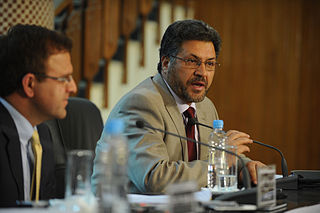
Almon Brown Strowger was an American inventor who gave his name to the Strowger switch, an electromechanical telephone exchange technology that his invention and patent inspired.
Ishaq M. Shahryar was the inventor of the low-cost photovoltaic cell and the first Afghan ambassador to the United States since the Soviet Invasion of Afghanistan in 1979. New Scientist named Shahryar "the Sun King," recognizing his virtual invention of solar power as a serious energy source and honoring his dedication to reinventing Afghan villages through solar power and increased business opportunities.
In patent law, an inventor is the person, or persons in United States patent law, who contribute to the claims of a patentable invention. In some patent law frameworks, however, such as in the European Patent Convention (EPC) and its case law, no explicit, accurate definition of who exactly is an inventor is provided. The definition may slightly vary from one European country to another. Inventorship is generally not considered to be a patentability criterion under European patent law.
Anooshe Sediq Ghulam (1979–2002) was a 22-year-old Afghan refugee in Norway, who was murdered by her husband, Afghan Nasruddin Shamsi, in an "honour killing".
Hisa-e-Awali Behsud is a district of Maidan Wardak Province, Afghanistan. The district has a Hazara majority resident population, but the district is also used as grazing ground by nomadic Pashtun Kuchis. The Hajigak Mine is located in the district.

Saydabad District is a district of Maidan Wardak Province, Afghanistan. The district is known for its pleasant climate, including hilly vegetation, streams, and orchards. The district was a popular retreat for Kabul residents until an increase in ISAF-Taliban violence in the late 2000s. The city of Saydabad serves as the district capital. With a population of 114,793, it is the most populous district of the province.
The Lemelson Foundation is an American 501(c)(3) private foundation. It was started in 1993 by Jerome H. Lemelson and his wife Dorothy. The foundation held total net assets of US$444,124,049 at the end of 2020 and US$484,432,021 at the end of 2021. The Foundation seeks to harness the power of invention and innovation to accelerate climate action and improve lives around the world.

Mohammad Jan Abdullah Wardak was an Afghan politician and former Mujahideen commander. He served as a government Minister and Governor of Logar Province.
Habibia High School is a school in Kabul, Afghanistan which has educated many of the former and current Afghan elite, including former Presidents Ashraf Ghani and Hamid Karzai, as well as musician Ahmad Zahir. It was founded by King Habibullah Khan in 1903 and is considered one of the oldest schools In Afghanistan. It is situated in Karteh Seh, a district in the south of the Afghan capital.
Abdul Ahad Khan Wardak was a politician from northern Afghanistan.

Ghulam Farooq Wardak is a politician in Afghanistan, formerly serving as the Minister of Education. He was appointed to that position by Afghan President Hamid Karzai on October 11, 2008.

Mohammed Daud Miraki is an Afghan activist, writer and politician.

The Wardak or Wardag are a tribe of the Pashtun people. That mainly live in the Wardak Province of Afghanistan. They migrated to the Wardak province in around 1730. Although they are mainly found in Afghanistan, they can also be found in Peshawar, Attock and Dir in Khyber Pakhtunkhwa province of Pakistan.

Amin Wardak is a major Afghan mujahideen leader who mostly fought against the Afghan communist regime and the Soviet invaders in his home region of Maidan Wardak Province during the Soviet–Afghan War in the 1980s. However, his reach of military actions had spread till the provinces of Ghazni and Kabul, and his political influence and relations towards the other mujahideen groups reached even further.

The United States provided many inventions in the time from the Colonial Period to the Gilded Age, which were achieved by inventors who were either native-born or naturalized citizens of the United States. Copyright protection secures a person's right to his or her first-to-invent claim of the original invention in question, highlighted in Article I, Section 8, Clause 8 of the United States Constitution, which gives the following enumerated power to the United States Congress:
To promote the Progress of Science and useful Arts, by securing for limited Times to Authors and Inventors the exclusive Right to their respective Writings and Discoveries.
Ghulam Husain Naseri is an ethnic Hazara politician in Afghanistan. He is the former representative of the people of Maidan Wardak during the 16th term of Afghanistan Parliament.
Zakia Wardak is an Afghan architect, politician, and businesswoman. She served as the first female Consul General of Afghanistan in Mumbai. Wardak is an advocate for inclusion and women's rights. She is from Kabul. Wardak has served as president of the Society of Afghan Women in Engineering and Construction. In 2018, she ran for a seat in the 2018 Afghan parliamentary election.







